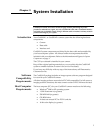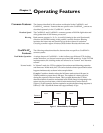
Chapter 3. Operating Features 11
Application Examples
Example 1
"I have a CoolSNAP
ES
and want to operate the camera in the most sensitive
setting for taking high-resolution, single images."
For this application, the camera should be operated in "alternate normal" mode
to provide the best quantum efficiency and the camera gain should be set to 2.
These settings will operate the camera in its most sensitive mode.
Example 2
"I would like to acquire sequences of images with a CoolSNAP
ES
to study time-
correlated phenomena. My light level is fairly high and I want to optimize the
acquisition rate of the camera."
First, the camera speed should be set to 20 MHz. In addition, the camera should
be put into "normal" mode to take advantage of the overlapping of the readout
with the integration time. Finally, the "clearing" mode of the camera should be
set to "clear pre-sequence" to remove the clearing overhead between frames. Of
course, reducing the region of interest and increasing binning will always
increase the frame rate further.


















